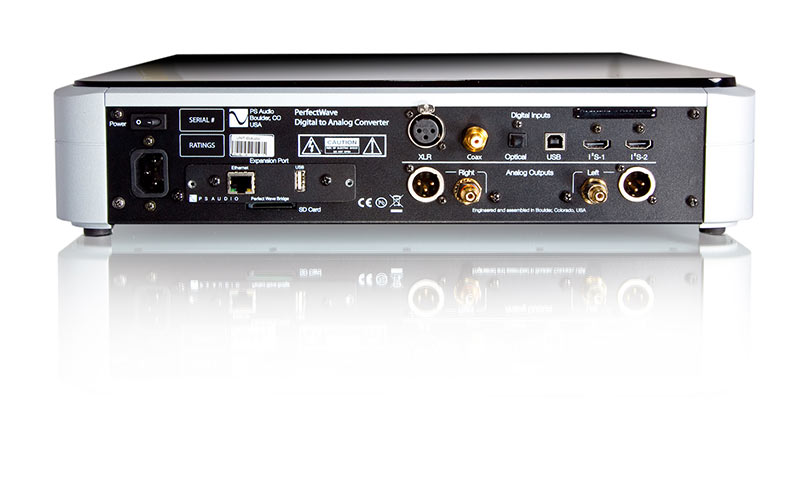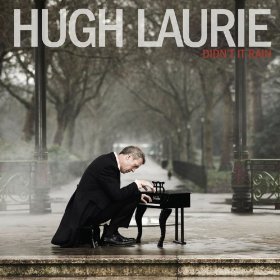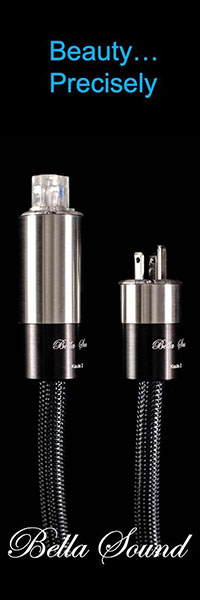PS Audio PerfectWave DirectStream DAC


What’s all this fuss about DSD? Well, according to Paul McGowan, CEO of PS Audio, although almost all Red Book CD’s were recorded as PCM (Pulse-code modulation) digital files, Sony and Phillips should have waited a few more years, until 1988, to introduce a CD that used the single-bit, 2.8MHz sampling rate of DSD (Direct Stream Digital). And, as it happened, Sony and Phillips developed a DSD format, known as SACD (Super Audio CD), but it was not introduced until 1999 and was not as successful as CD in the mainstream market. Possible reasons for SACD not becoming as commercially successful as CD include its more limited appeal to a smaller niche market (audiophiles), and its higher price per disc.
Paul claims, as do many, that DSD-based digital recordings simply sound “better” (more like the original master tapes) than those recorded in PCM. And basically, what the DirectStream does is to convert PCM files to DSD while using multi-stage filtering to reduce the incoming jitter to extremely low, practically undetectable levels. The high-accuracy Master Clock is located only about 0.25 inches from the analog output transformer so that no more jitter can creep in at that crucial juncture. Thus the analog output is transformer coupled, which also helps keep noise out of the music signal.
Further, PS Audio has chosen to forgo the use of any off-the-shelf D to A processor chip, and to instead employ an FPGA (Field Programmable Gate Array) as DirectStream’s core processor. This set up has certain advantages such as a simplified signal path and not the least of which is providing easy, performance-enhancing upgrades via a common SD card. I will elaborate on my experience with this later in the review.
The FGPA upsamples the incoming digital data to ten times the standard 2.8MHz DSD rate before processing initiates. After processing the data is converted to double-rate DSD at 5.6MHz. The resulting digital stream is fed through the passive analog filtering network and finally to the high-quality audio transformer I mentioned previously. According to PS literature, this circumvents the alteration and loss of high frequencies that is common in competing designs using active analog output circuitry.
DirectStream’s principle collaborator/designer, Ted Smith claims that the various types of digital inputs that DirectStream provides will all have the same ultra-low jitter spec and should sound identical, or nearly identical. An added plus of the design is that there are no snaps or pops when changing inputs. He also pointed out that using the Toslink input can eliminate ground loop problems. I did have a bit of a ground loop issue during my initial set up of DirectStream, which I resolved by using a 2-prong AC cheater plug to plug it into the Monarchy Audio P100 power regenerator. Ted believes strongly that the DirectStream, and really any DAC, should be fed clean power and I am in total agreement on that point.
The PS Audio DirectStream is physically large for a DAC measuring 17”x14”x4” and weighing in at 22 pounds. So you will need a full size shelf to support this bad boy. Part of the reason for its largeness was to allow the components to be laid out in a manner that would decrease noise, hum, and jitter by keeping power-supply components away from the digital stream and signal path. And indeed, the DirectStream reduces jitter and noise to vanishingly low levels. This may account for its superb image focus and its unprecedented clarity in reproducing instruments and voices.
Features

The DirectStream offers 6 digital inputs including two I2S (on HDMI), XLR, Toslink optical, Asynchronous USB, and S/PDIF on coax RCA. If you include the optional $799 PerfectWave Network Bridge (enables streaming off the www or network audio server) then you’ll have 7 total digital inputs encompassing many avenues for musical bliss.
To control your DirectStream’s functions and settings you can use either the color touch screen on the unit or the full function remote control that comes with it. It took a little reading and discovery to understand all the functions. For instance there is a “Dim” button on the remote that turns off the display and to turn it back on, one must press the “On” button. Also, pressing the “Filter” button reduces the Volume by 20dB. It appears that the remote can be used to control other PS Audio devices as well. There is the familiar PowerPlant keypad and another keypad area that is intended to be used with the PerfectWave Transport.
A few weeks after the first batch of DirectStream DAC’s were released, PS Audio announced an upgrade that could be downloaded to one’s computer, then loaded on an SD card and plugged into the back panel of the DS to install the upgrade. I was easily able to install it. From what I understand, it was a modification to the high frequency filtering profile and an improvement to the operation of the balance control. The upgrade resulted in worthwhile performance enhancements, which I will soon explain.
Since the DirectStream offers full preamp functions for virtually any stereo digital source, it can serve as the heart of an extremely high-performance audio system. A transparent, bit-perfect Volume control along with channel Balance, Source selection, and 2 different Mute functions (full mute and -20dB) eliminate the need for a traditional preamplifier in any system not using analog sources, i.e., a tuner, turntable, or tape recorder/player.
 Setup
Setup
I installed the DirectStream in my small-room reference system, which is a very simple but highly resolving and musical system. I used my ear-proven Lenovo T-60 Thinkpad to feed the DirectStream via the USB asynchronous input. DirectStream’s RCA outputs were fed to the recently reviewed Luminous Audio Axiom II (Walker mod) passive preamp, which delivered the music signal to a pair of modified Dignity Audio 300B monoblock amplifiers. The 300B’s drove my Wavetouch Audio Grand Teton reference speakers.
I also listened to the DirectStream feeding a Melody Sp3 Mk-II tube amplifier driving a pair of Magnepan SMGa speakers. The Magnepan system is not as revealing or finely detailed as the Wavetouch GT system, but it is superbly musical.
To provide clean AC power to DirectStream, Monarchy Audio’s P-100 power regenerator was employed. Another very good DSD DAC, the Wyred 4 Sound DAC-2 DSDse was used in the system as a quality and performance reference (full review coming up soon).
Listening impressions
I was quite impressed with my first listen to DirectStream. The soundstage is enormous and the high-frequencies seem to reach out to forever… and yet the highs are easy on the ears. Individual instruments and voices have a bit more body and thereby appear more holographic. Dynamics can go from extremely soft to startlingly loud in the blink of an eye.
But what impresses me most about DirectStream is its superb degree of instrumental focus and its benchmark level of clarity. It’s like all the extraneous noise, fuzz, and general bloat has been skimmed off the music signal leaving only the pure music itself. It provides a pristine pellucid pane that is unprecedented in my experience.
At virtually the same time I received the DirectStream for review I also took delivery on the Wyred 4 Sound DAC-2 DSDse, which is a very good quality DSD DAC with very high parts quality and using the ESS Sabre DAC Chip. The W4S DAC is less than half the price of the DirectStream and it shares many of the same features with actually a bit more user control than the DirectStream provides. I figured it would give the DirectStream a run for the money. And it did… especially at first.
In my head-to-head comparison with DirectStream, the DAC-2 DSDse had more dynamic bounce and sounded slightly more harmonically sweet and musical. Still, it was not as extended in the highs and seemed a bit more closed in. By contrast, DirectStream was clearer and had better image focus and revealed more fine detail. Yet, on certain tracks the DirectStream sounded more matter-of-fact and less musical than the DAC-2 DSDse. And when I played some hi-res tracks I made from my LP records using the PS Audio NuWave Phono Converter the DirectStream lacked the lively musical presence I had heard previously using the W4S and other DACs. This surprised me.
About that time, Paul McGowan contacted me and said that they had a firmware upgrade that in his opinion made a significant improvement in DirectStream’s performance. I installed the upgrade from an SD card he sent, and voila! All was well with the world. Apparently reprogramming the FPGA is akin to getting a new and improved DAC without needing to change the hardware.
With the upgrade, DirectStream became a different, more-sexy and more musical animal than its predecessor. Gone was the dryer more analytical bent, and in its stead was a magnificently musical marvel, the likes of which I had never before experienced. The Wyred 4 Sound DAC now had nothing on DirectStream and was noticeably outclassed by DirectStream’s ultra-clarity, vocal intelligibility, fine detailing and articulate airy highs.
 Everything I played from that point forward sounded superb, whether it was Eva Cassidy belting out “Wonderful World,” with its copious sense of space surrounding her vocal and its wonderful feathery treble, or Hugh Laurie’s rendition of “I Hate a Man Like You” from his Didn’t It Rain CD (Warner Bros. 535893-2) which features a great, gritty female vocal, perfect plucked guitar strings, and poignant, puissant drum rolls. The DirectStream served it up perfectly raw and intimate. Whether it was the Red Book CD standard or a hi-res 24bit/192kHz AIFF file DirectStream never failed to breathe musical life into each and every song.
Everything I played from that point forward sounded superb, whether it was Eva Cassidy belting out “Wonderful World,” with its copious sense of space surrounding her vocal and its wonderful feathery treble, or Hugh Laurie’s rendition of “I Hate a Man Like You” from his Didn’t It Rain CD (Warner Bros. 535893-2) which features a great, gritty female vocal, perfect plucked guitar strings, and poignant, puissant drum rolls. The DirectStream served it up perfectly raw and intimate. Whether it was the Red Book CD standard or a hi-res 24bit/192kHz AIFF file DirectStream never failed to breathe musical life into each and every song.
All the instruments had a convincing, right-there immediacy, and if this is not enough I must say that the DirectStream has the widest, deepest, and most holographic imagery I’ve ever experienced. Just play a track like Lindsey Stirling’s “Moon Trance” from her self-titled CD (Lindseystomp Music 6892157540). It’s so sonically encompassing you’ll have to pinch yourself to see if you aren’t dreaming!
What impressed me even more was playing the old Chicago II CD I borrowed from my brother and hearing that famous Chicago horn section sound fantastic… great old songs like “Wake up Sunshine,” and “Make Me Smile” were just ablaze with life and rhythm. And “Colour My World” has a flute solo near the end that is truly captivating played through DirectStream.
I had my friend Jim over to see what he’d say about DirectStream. During the session we found ourselves looking at each other in disbelief of the sonic dreamscape that spread wide before us. Finally Jim leaned over and asked “How could it possibly get any better?” I told him I didn’t know and we went right back to listening in rapt wonderment.
Conclusion
After listening to the PS Audio PerfectWave DirectStream DAC for the past few months it is my opinion that DirectStream represents a new benchmark in audio reproduction. Notice that I didn’t say “digital audio reproduction.” In other words, in my view the PS Audio DirectStream is the most musically and technically capable device of any type that I’ve ever had the pleasure to evaluate. My heartfelt congratulations go out to Paul McGowan, Ted Smith, and PS Audio’s excellent design team for making DirectStream a reality for those of us who truly love our music.
At nearly $6,000, DirectStream is not inexpensive, but by today’s standards for the wealth of musical improvement it offers, I consider it a bargain. Personally, I had to stretch my budget to buy the review sample, but frankly after hearing the immediacy, dynamic capability, and immense soundstage that DirectStream provides I couldn’t bear to send it back.


frank alles
Manufacturer
PS Audio
4826 Sterling Drive
Boulder, CO 80301
Phone: 1 720.406.8946
Web: www.psaudio.com
Description
PS Audio PerfectWave DirectStream DAC
Dimensions: 17”W x 14”D x 4H”
Net Weight: 22 lbs.
Price: $5,999.95 USD
Please visit: http://www.psaudio.com/directstream-dac/ for more information on specs and features.
Stereo Times Masthead
Publisher/Founder
Clement Perry
Editor
Dave Thomas
Senior Editors
Frank Alles, Mike Girardi, John Hoffman, Russell Lichter, Terry London, Moreno Mitchell, Paul Szabady, Bill Wells, Mike Wright, Stephen Yan, and Rob Dockery
Current Contributors
David Abramson, Tim Barrall, Dave Allison, Ron Cook, Lewis Dardick, Dan Secula, Don Shaulis, Greg Simmons, Eric Teh, Greg Voth, Richard Willie, Ed Van Winkle, and Rob Dockery
Music Reviewers:
Carlos Sanchez, John Jonczyk, John Sprung and Russell Lichter
Site Management Clement Perry
Ad Designer: Martin Perry





Be the first to comment on: PS Audio PerfectWave DirectStream DAC